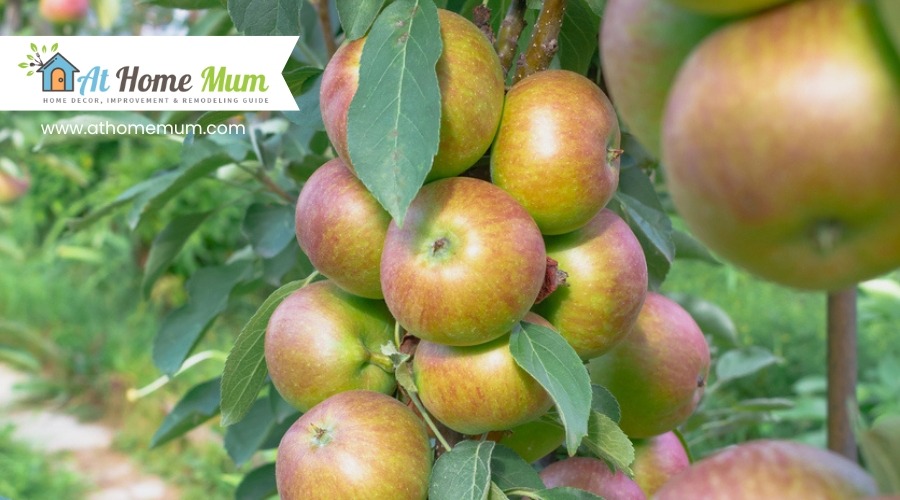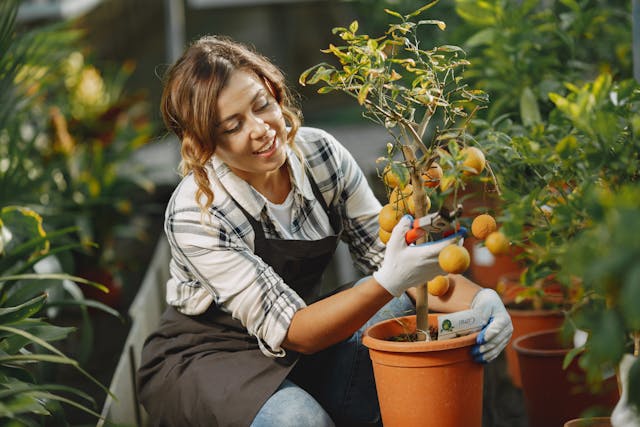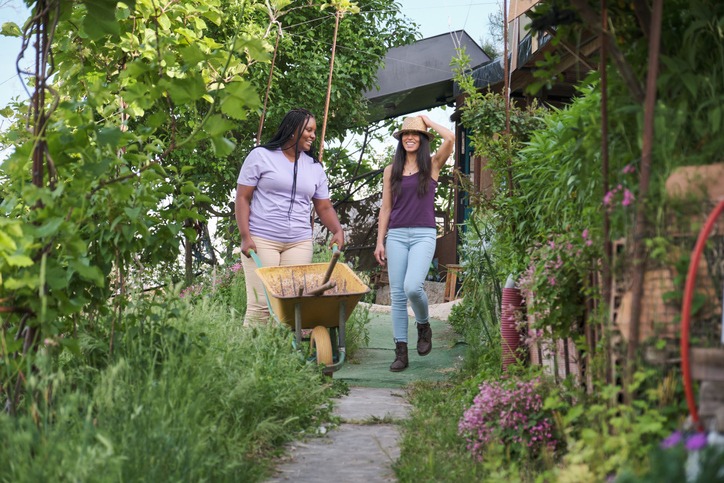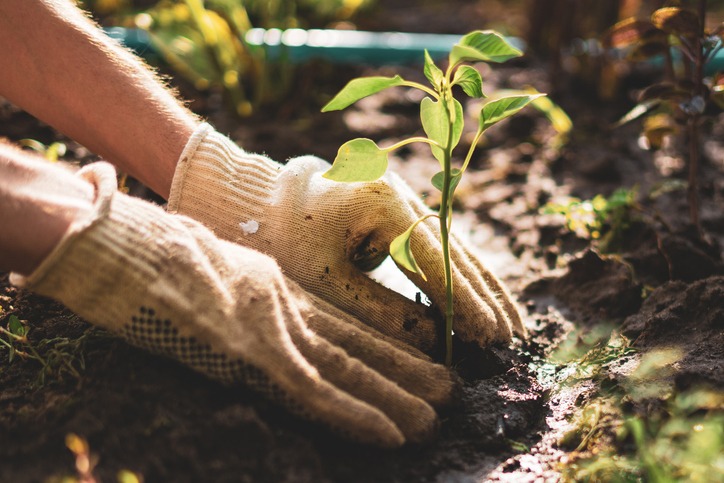Columnar fruit trees offer an efficient solution for fruit gardening enthusiasts who face the common challenge of limited space. Unlike traditional fruit trees which spread outwards, columnar varieties grow upwards, maintaining a slender profile. This unique growth habit makes them particularly well-suited for use in confined areas such as balconies and patios. As they grow vertically, they occupy much less horizontal space, enabling even the smallest of gardens to host a variety of fruit-bearing trees.
These trees are not only space-saving but also aesthetically pleasing, bringing a touch of greenery and the opportunity to harvest fresh fruit from the comfort of one’s own home. With branches that are naturally short, columnar fruit trees require minimal pruning, further simplifying their maintenance. This makes them ideal for those who desire a low-effort approach to gardening without compromising their ability to enjoy homegrown produce.
Balcony and patio gardeners particularly benefit from the columnar trees’ manageable size. Containers can accommodate these compact varieties, making them portable and adaptable to changing sunlight patterns and space uses on a patio or balcony. Despite their small footprint, columnar fruit trees do not skimp on yield; they are bred to produce a plentiful harvest, just like their larger counterparts, ensuring that even gardeners with the most modest of spaces can experience the rewards of growing their own fruit.
Understanding Columnar Fruit Trees
Columnar fruit trees offer space-saving growth and ample fruit production, ideal for confined spaces like balconies and patios.
Characteristics of Columnar Trees
Columnar fruit trees display a unique growth pattern. They typically reach a height of 8 to 10 feet at maturity and maintain a slim width of about 2 to 3 feet. Unlike standard apple trees that spread out, true columnar trees grow upwards with minimal horizontal branching, making them a snug fit for smaller gardens.
| Trait | Description |
|---|---|
| Height | 8 to 10 feet, suitable for under-canopy or low-clearance areas |
| Width | 2 to 3 feet, narrow profile to fit tight spaces |
| Branching | Vertical with short lateral branches, compact form |
| Fruit Bearing | Normal-sized fruit analogous to those of standard trees |
Columnar trees, such as the ‘Golden Sentinel’ and ‘Scarlet Sentinel’ apple varieties, or the ‘Northpole’, exhibit a slim silhouette with vertical branching. This characteristic not only enhances space efficiency but also simplifies maintenance and harvest.
Varieties Suitable for Balconies and Patios
Columnar apple trees are a popular choice for balconies and patios. Hardy and attractive, the aforementioned ‘Golden Sentinel’, ‘Scarlet Sentinel’, and ‘Northpole’ are prime examples of varieties that flourish in confined spaces. Each of these varieties provides the following benefits:
- Ease of Care: Requiring less pruning than conventional apple trees.
- Aesthetic Appeal: Their slender growth habit grants a visually appealing structure throughout the year.
- Fruit Production: Despite their size, they produce a generous yield of full-sized apples.
The selected apple varieties thrive even in limited soil volumes found in containers. This attribute makes columnar apple trees particularly fitting for balconies and patios, where ground planting isn’t feasible.
Advantages of Columnar Trees in Limited Spaces
Columnar fruit trees offer urban gardeners with limited outdoor spaces a viable solution to grow fresh fruit. Their slender growth shape and minimal footprint are particularly beneficial for balcony and patio gardens.
Space Efficiency
Columnar trees are the embodiment of space-saving vegetation. Their vertical growth habit allows them to be planted in narrow spaces, ideal for balcony gardens and small patios. A typical columnar fruit tree reaches a mere 8 to 10 feet tall and 2 to 3 feet wide, making them much more compact than standard trees that can grow over 20 feet high.
Ease of Harvest
Harvesting fruit from a columnar tree is remarkably straightforward. The trees’ accessible heights and upright form mean that ladders are often unnecessary. This makes them perfect for balconies and patios where space for harvesting equipment is limited.
Aesthetic Appeal
The sleek and upright nature of columnar trees adds a modern touch to any garden setting. Their slender growth shape not only looks elegant but also complements the vertical lines of urban architecture, making them suitable for terraces and small gardens.
Less Pruning Required
Compared to standard trees, columnar varieties demand far less pruning. Their natural growth habit minimizes the need for regular shaping. This low-maintenance characteristic is especially favorable for those with congested schedules or small gardening spaces such as balconies where extensive upkeep is impractical.
Growing Columnar Fruit Trees
Columnar fruit trees are an innovative option for garden enthusiasts with limited space, such as balconies and patios. They provide an opportunity to enjoy home-grown fruit without the extensive area typically associated with traditional fruit trees.
Planting and Soil Requirements
For successful growth, columnar fruit trees require well-draining soil rich in organic matter. Gardeners should use potting mix when planting in containers, ensuring it is loose and fertile. When introducing the tree to a pot or garden soil, it’s important to plant at the same depth as the tree’s rootball. Ideally, the rootstock should be completely covered but the graft union must be above soil level to prevent rotting.
Watering and Nutrient Management
Regular watering is essential, as columnar fruit trees do not tolerate drought. However, they also dislike waterlogged conditions, making proper drainage paramount. For nutrients, a balanced approach incorporating both fertilizer and compost is recommended. This will provide a slow release of nutrients necessary for growth. Over the growing season, one should apply a balanced liquid fertilizer monthly.
Support and Structural Care
While columnar trees are bred for their upright habit, they may sometimes require support to maintain structure, particularly when heavily laden with fruit. Stakes or trellises provide the necessary support. Structural care involves pruning to remove any dead or diseased wood and to encourage airflow, as well as annual checks on ties and supports for signs of wear or damage.
In maintaining columnar fruit trees, attention to detail in the areas of planting, soil composition, watering regularity, and structural support will ensure a healthy plant capable of producing fruit even in constrained spaces.
Pollination and Fruit Yield
Columnar fruit trees, including varieties of apples, pears, cherries, and plums, can effectively produce abundant yields even in the confined spaces of balconies and patios. Proper pollination strategies are key to maximizing fruit production for these compact growers.
Understanding Pollination Needs
Columnar fruit trees often require pollination to set fruit. Self-pollinating varieties, such as some apple and pear trees, can bear fruit without cross-pollination, making them ideal for limited space gardens. However, certain species, including many cherries and plums, often yield better when cross-pollinated with compatible partners.
Maximizing Yield
To maximize the yield of columnar fruit trees:
- Ensure the presence of pollinators, such as bees, to transfer pollen.
- Plant in areas with adequate sunlight and airflow to promote healthy pollinator activity.
- Introduce companion plants that attract beneficial insects to aid in pollination.
Regular care, including proper pruning and watering, is also essential to support a healthy yield.
Cross-Pollination Strategies
For tree types that are not self-pollinating, employing cross-pollination strategies is crucial:
- Plant two or more compatible varieties in proximity to encourage pollination.
- Select apple and pear varieties that blossom simultaneously to enhance the chances of cross-pollination.
- Consider using pollinator gardens or attracting agents like bees to ensure that pollen is transferred effectively.
By understanding the pollination needs of their fruit trees and implementing strategies that facilitate cross-pollination, balcony and patio gardeners can enjoy a fruitful harvest.
Protecting Your Fruit Trees
Maintaining the health of columnar fruit trees on balconies and patios requires vigilance against pests and diseases, as well as precautions for adverse weather conditions. These compact trees need specific care strategies due to their unique growing environments.
Dealing with Pests and Diseases
Columnar fruit trees, like their larger counterparts, are susceptible to various pests and diseases. To protect these trees, one should regularly inspect them for signs of infestation or illness. Common pests include aphids, spider mites, and caterpillars, which can be managed using insecticidal soap or neem oil treatments. For diseases such as powdery mildew or fire blight, removing affected parts immediately and applying appropriate fungicides or bactericides is crucial.
- Pest Control Actions
- Inspect leaves and fruit for pests
- Apply insecticidal soap or neem oil
- Remove and destroy infected plant parts
- Disease Prevention Measures
- Prune to promote air circulation
- Avoid overhead watering to reduce leaf wetness
- Apply fungicides or bactericides if needed
Using dwarfing rootstocks for these trees not only controls their size but also can increase their resistance to certain soil-borne diseases.
Weather-Related Considerations
Columnar fruit trees on balconies and patios face specific challenges due to exposure to the elements. Frost can damage budding flowers and fruitlets, so providing frost protection with burlap or fleece covers during unexpected cold snaps is advisable. To mitigate wind damage, securing trees to railings or using windbreaks can prevent branches from breaking and reduce the risk of trees toppling.
- Frost Protection
- Cover with burlap or fleece
- Move containers to a sheltered location if possible
- Wind Protection
- Secure to railings or add supports
- Use windbreaks like trellises or shrubs
Regular care practices, such as mulching to maintain soil temperature and moisture, also contribute to the overall resilience of columnar fruit trees against adverse weather conditions.
Harvesting and Storage
When cultivating columnar fruit trees on balconies and patios, harvesting and storage are critical for maintaining fruit quality. Proper timing and techniques are essential for picking, while correct storage conditions prolong the freshness of your harvest.
Timing and Techniques for Picking Fruit
For columnar fruit trees such as apples, pears, peaches, plums, cherries, and damsons, timing is paramount. One should monitor the fruit for signs of maturity, which may include a change in color and ease of separation from the branch. Thinning out excess fruit early in the season can lead to a higher quality harvest later on.
- Apples and Pears: Typically ready in late fall. Picking should occur when fruits detach easily from the tree and the flesh feels firm yet slightly yielding.
- Peach and Plum: These fruits should be harvested when they give a little to the touch and the aroma is noticeable.
- Cherry and Damson: Best picked when they have reached full color and the flesh is juicy.
Storing Your Garden’s Produce
After harvesting, proper storage methods can extend the shelf life of your fruit. For most balcony-grown fruits, a cool, dark place with adequate air circulation is ideal for storage.
Optimal Storage Conditions:
| Fruit Type | Temperature Range | Relative Humidity |
|---|---|---|
| Apples | 30-40°F (-1-4°C) | 90-95% |
| Pears | 30-40°F (-1-4°C) | 85-90% |
| Peach | 32°F (0°C) | 85-90% |
| Plum | 30-40°F (-1-4°C) | 85-90% |
| Cherry | 32°F (0°C) | 85-90% |
| Damson | 32°F (0°C) | 85-90% |
It is essential to check on stored fruits regularly and remove any showing signs of spoilage to prevent it from affecting the rest. Small quantities from balcony gardens allow for easier monitoring and upkeep.
Long-Term Care and Maintenance
Proper long-term care and maintenance of columnar fruit trees are essential for their health and productivity. Specific practices such as pruning, nutrient management, and understanding their lifecycle contribute significantly to a fruitful balcony or patio orchard.
Pruning and Managing Growth
Columnar fruit trees typically require minimal pruning compared to their traditional counterparts. They should mainly have their dead branches removed to maintain health and vigor. Pruning should be done annually to manage growth and encourage the development of fruiting spurs. A straightforward procedure includes:
- Late winter: Prune to remove dead or diseased wood.
- After fruit set: Thin fruits to avoid overburdening the tree.
Soil and Nutrient Replenishment
Columnar fruit trees grown in containers on balconies and patios rely on their caretakers for soil and nutrient replenishment. They often deplete the nutrients available in their limited soil volume, making regular fertilization important. Key practices involve:
- Annually: Refresh the top layer of soil with compost to provide nutrients.
- Spring and Summer: Apply a balanced fertilizer to promote healthy growth.
Nutrient replenishment should be tailored to the tree species and current soil conditions, as over-fertilization can be detrimental.
Lifecycle and Replacement
The average lifespan of a columnar fruit tree can be up to 20 years with proper care. They rarely require transplanting due to their compact nature. It is important for caretakers to monitor the tree’s health and vigor over the years. Lifecycle management tips include:
- Monitor growth: Healthy trees will show vigorous growth and consistent fruiting.
- If a tree’s performance declines, it may be reaching the end of its productive life and should be replaced to maintain the productivity of the balcony or patio orchard.
Choosing Containers and Accessories for Your Trees
When selecting containers and accessories for columnar fruit trees, one must consider size, durability, and support structures to ensure healthy growth and fruit production.
Selecting the Right Pots and Containers
The appropriate pot or container is essential for the well-being of a columnar fruit tree. They should be selected based on:
- Size: Containers need to be large enough to accommodate the tree’s root system. Pots should generally be at least 18 inches in diameter to start with, but specific size requirements may increase as the tree matures.
- Material: Consider materials like terracotta, ceramic, or high-grade plastic that provide stability and withstand environmental changes. Whiskey barrels are a popular choice due to their size and the rustic aesthetic they provide.
Structural Additions for Better Growth
To enhance the growth of columnar fruit trees, certain structures can be incorporated:
- Support: Trees may benefit from supportive structures, especially when laden with fruit. One can use stakes, or tie the main trunk to a screen or wall to ensure it grows upright.
- Fan Training: For those looking for advanced methods, fan training against a flat surface can promote equal sunlight exposure and air circulation. Fans require a strong framework for attachment.
Suitable on the bottom of the containers are crucial for water drainage to prevent root rot. It’s clear that both container choice and structural support are pivotal for the thriving of columnar trees in balcony and patio gardens.







